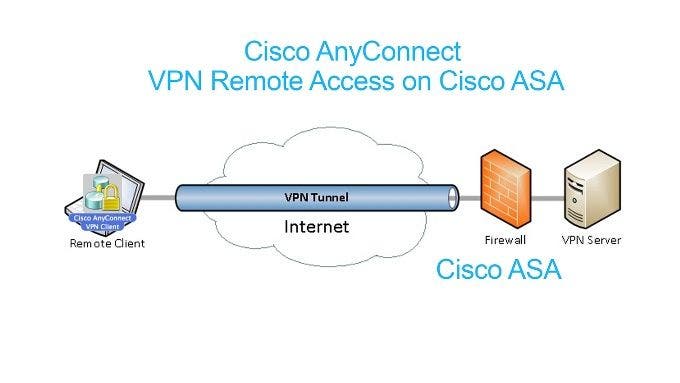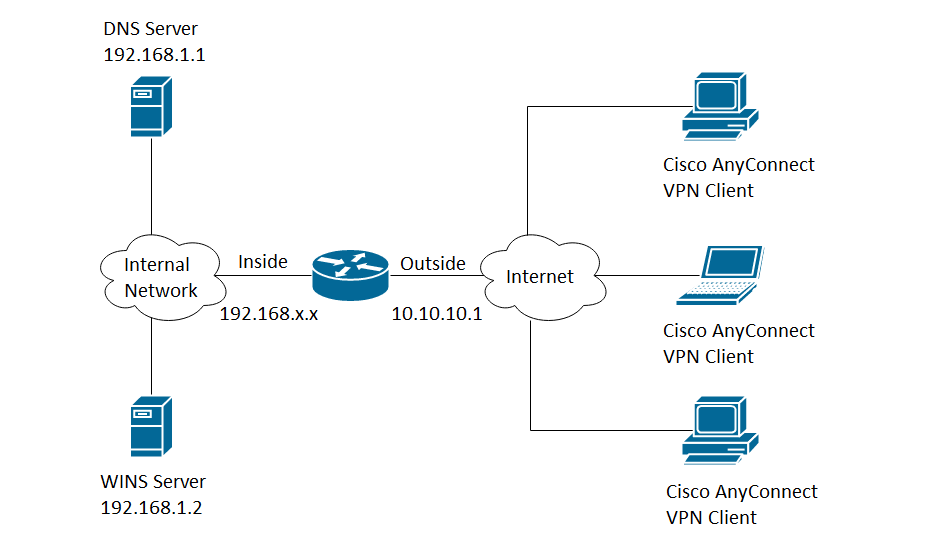Cisco Anyconnect Vpn Router
- Cisco Anyconnect Vpn With Verizon Wireless Router
- Cisco Anyconnect Vpn Setup Asdm
- Cisco Anyconnect Vpn Setup
Topics Map Networking Virtual Private Networking (VPN) VPN, CISCO AnyConnect, How to configure your router or firewall. I'm not able to connect to VPN from my home network.
- In this post I will explain how to configure WEB VPN (or sometimes called SSL VPN) using the Anyconnect VPN client on a Cisco 870 router. However the configuration example and concept is the same for other Cisco router models as well. Web Based VPN has three Remote Access modes.
- The VPN Pool called VPNPOOL must be defined on the hub router. Same applies for the ZBFW configuration, everything must already be configured, all you are doing is dynamically defining which zone the virtual-access interface will be a member of.
- Hello, I've tried searching through the discussions/faq's and can't seem to find a solution to my VPN issue. I have a work laptop with Cisco Anyconnect VPN software installed and it can connect to work just fine if I use my old N600 wifi router. However, my XR500 is blocking something and doesn.
Introduction

This document provides a sample configuration of how to configure an IOS/IOS-XE headend for remote access using AnyConnect IKEv2 and AnyConnect-EAP authentication method with local user database.
Prerequisites
Requirements
Cisco recommends that you have knowledge of these topics:
- IKEv2 protocol
Components Used
The information in this document is based on these software and hardware versions:
- Cisco Cloud Services Router running IOS XE 16.9.2
- AnyConnect client version 4.6.03049 running on Windows 10
The information in this document was created from the devices in a specific lab environment. All of the devices used in this document started with a cleared (default) configuration. If your network is live, make sure that you understand the potential impact of any command.
Background Information
AnyConnect-EAP, also known as aggregate authentication, allows a Flex Server to authenticate the AnyConnect client using the Cisco proprietary AnyConnect-EAP method. Unlike standard based Extensible Authentication Protocol (EAP) methods such as EAP-Generic Token Card (EAP-GTC), EAP- Message Digest 5 (EAP-MD5) and so on, the Flex Server does not operate in EAP pass-through mode. All EAP communication with the client terminates on the Flex Server and the required session key used to construct the AUTH payload is computed locally by the Flex Server. The Flex Server has to authenticate itself to the client using certificates as required by the IKEv2 RFC.
Local user authentication is now supported on the Flex Server and remote authentication is optional. This is ideal for small scale deployments with less number of remote access users and in environments with no access to an external Authentication, Authorization, and Accounting (AAA) server. However, for large scale deployments and in scenarios where per-user attributes are desired it is still recommended to use an external AAA sever for authentication and authorization. The AnyConnect-EAP implementation permits the use of Radius for remote authentication, authorization and accounting.
Network Diagram
Cisco Anyconnect Vpn With Verizon Wireless Router
Configure
Authenticating and Authorizating users using the Local Database
Cisco Anyconnect Vpn Setup Asdm
Note: In order to authenticate users against the local database on the router, EAP needs to be used. However, in order to use EAP, the local authentication method has to be rsa-sig, so the router needs a proper certificate installed on it, and it can't be a self-signed certificate.

Sample configuration that uses local user authentication, remote user and group authorization and remote accounting.
Step 1. Enable AAA, and configure authentication, authorization and accounting lists and add a username to the local database:

Step 2. Configure a trustpoint that will hold the router certificate. PKCS12 file import is used in this example. For other options, please consult the PKI (Public Key Infrastructure) configuration guide:
https://www.cisco.com/c/en/us/td/docs/ios-xml/ios/sec_conn_pki/configuration/xe-3s/sec-pki-xe-3s-book/sec-cert-enroll-pki.html
Step 3. Define an IP local pool to assign addresses to AnyConnect VPN clients:
Step 4. Create an IKEv2 local authorization policy:
Step 5 (Optional). Create desired IKEv2 proposal and policy. If not configured, smart defaults will be used:
Step 6. Create AnyConnect profile
Note: The AnyConnect profile needs to be delivered to the client machine. Please refer to the next section for more information.
Configure the client profile using the AnyConnect Profile Editor as shown in the image:
Click 'Add' to create an entry for the VPN gateway. Make sure to select 'IPsec' as 'Primary Protocol'. Uncheck the 'ASA gateway' option.
Save the profile by going to FIle -> Save As. The XML equivalent of the profile:
Note: AnyConnect uses '*$AnyConnectClient$*' as its default IKE identity of type key-id. However, this identity can be manually changed in the AnyConnect profile to match deployment needs.
Note: In order to upload the XML profile to the router, IOS-XE 16.9.1 version or later is required. If older version of IOS-XE software is used, the profile download capability needs to be disabled on the client. Please refer to the section 'Disabling the AnyConnect downloader capability' for more information.
Upload the created XML profile to the flash memory of the router and define the profile:
Note: The filename used for AnyConnect XML profile should be acvpn.xml.
Step 7. Create an IKEv2 profile for AnyConnect-EAP method of client authentication.
Note: Configuring the remote authentication method before the local authentication method will be accepted by the CLI, but will not take effect on versions that do not have the fix for the enhancement request CSCvb29701, if the remote authentication method is eap. For these versions, when configuring eap as the remote authentication method, ensure the local authentication method is configured as rsa-sig first. This problem is not seen with any other form of remote authentication method.
Note: On versions of code affected by CSCvb24236 , once remote authentication is configured before local authentication, the remote authentication method can no longer be configured on that device. Please upgrade to a version that has the fix for this code.
Step 8. Disable HTTP-URL based certificate lookup and HTTP server on the router:
Note: Referthis document to confirm whether your router hardware supports the NGE encryption algorithms (for example the example above has NGE algorithms). Otherwise IPSec SA installation on the hardware will fail at the last stage of negotiation.
Step 9. Define the encryption and hash algorithms used to protect data
Step 10. Create an IPSec profile:
Step 11. Configure a loopback interface with some dummy IP address. The Virtual-Access interfaces will borrow the IP address from it.
Step 12. Configure a virtual-template (associate the template in the IKEv2 profile)
Steap 13 (Optional). By default, all traffic from the client will be sent through the tunnel. You can configure split tunnel, which allows only selected traffic to go through the tunnel.
Step 14 (Optional). If all traffic is required to go through the tunnel, you may configure NAT in order to allow internet connectivity for remote clients.
Disabling the AnyConnect downloader capability (optional).
This step is only necessary if IOS-XE software version older than 16.9.1 is being used. Prior to IOS-XE 16.9.1 the capability to upload the XML profile to the router was not available. The AnyConnect client tries to perform download of the XML profile after successful login by default. If the profile is not available, the connection fails. As a workaround, it is possible to disable the AnyConnect profile download capability on the client itself. In order to do that, the following file can be modified:
The 'BypassDownloader' option should be set to 'true', for example:
After the modification, the AnyConnect client needs to be restarted.
AnyConnect XML profile delivery
With the fresh installation of the AnyConnect (with no XML profiles added), the user is able to manually enter the FQDN of the VPN gateway in the address bar of AnyConnect client. This results in the SSL connection to the gateway. The AnyConnect client will not attempt to establish the VPN tunnel with IKEv2/IPsec protocols by default. This is the reason why having XML profile installed on the client is mandatory to establish the IKEv2/IPsec tunnel with IOS-XE VPN gateway.
The profile is used when it is being selected from the drop-down list of AnyConnect address bar. The name that will appear is the same name as specified in 'Display Name' in AnyConnect profile editor. In this example the user should select the following:
The XML profile can be manually put into the following directory:
The AnyConnect client needs to be restarted in order for the profile to become visible in the GUI. It's not sufficient to close the AnyConnect window. The process can be restarted by right-clicking AnyConnect icon in the Windows tray and selecting 'Quit' option:
Communication flow
IKEv2 and EAP exchange
Verify
Use this section in order to confirm that your configuration works properly.
Troubleshoot

This section provides information you can use in order to troubleshoot your configuration.
- IKEv2 debugs to collect from the headend:
- AAA debugs to see assignment of local and/or remote attributes:
- DART from the AnyConnect client.
I'm going to update my original post above, but I was able to (finally) resolve the issue and wanted to share the solution. Thanks to some Internet searching, I learned of some settings in the Frontier/Netgear DSL modem/routers that is (as far as I can tell) designed to aid in forwarding various services through the router/firewall. From there, I was able to track it to the 'ALG' setting in the Port Forwarding area of the modem/router firmware. Here's what I did:
- Login to the DSL modem/router via the web interface
- Click on 'Advanced' at the top menu
- Click on 'ALG' under the section to the left denoted by the red toolbox icon
- Remove the checkmark for IPSec and click 'Apply'
- Reboot the modem/router
After doing this, I was able to successfully connect using the Cisco VPN Client software- hope this helps the next poor soul that runs into this! Hopefully it will save you that many hours over many days of troubleshooting it took me...
EDIT: Additional note- my home DSL router/model is a Netgear 7550 model, while it appears that both of the employees were issued the (presumably newer) Netgear D2200D model. The VPN seemed to pass through the 7550 model without an issue, so this may be an issue that's model specific.
Cisco Anyconnect Vpn Setup
Edited Oct 26, 2016 at 17:11 UTC